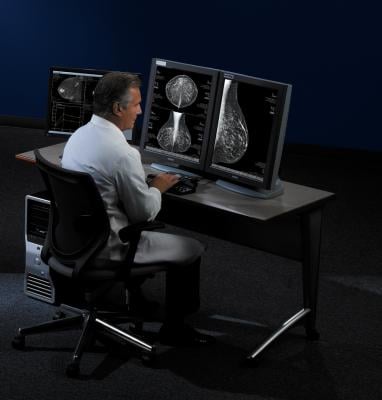
October 3, 2012 — Regular mammography screening can help narrow the breast cancer gap between black and white women, according to a retrospective study published in Breast Cancer Research and Treatment in August.
Earlier studies have shown that black women in Chicago are more than twice as likely to die of breast cancer compared to white women. Black women with breast cancer reach the disease’s late stages more often than white women, and their tumors are more likely to be larger and more biologically aggressive.
But according to the study, when women of both races received regular breast cancer screening — a mammogram within two years of breast cancer diagnosis — there was no difference in the rate of how many of them presented in the disease’s later stages.
The data result from a retrospective study conducted of women diagnosed with breast cancer from January 2001 to December 2006 at Rush University Medical Center and Northwestern Memorial Hospital in Chicago. Data were collected on 1,642 subjects, including 980 who were regularly screened and 662 who were irregularly screened.
“This study reinforces the fact that racial gaps in breast cancer outcomes can be improved,” said lead author Paula Grabler, an assistant professor of radiology at Northwestern University Feinberg School of Medicine and a radiologist at Northwestern Memorial Hospital. “One solution within reach is simple access to routine and regular mammography screening.”
One notable finding was that women screened regularly, regardless of race, were more likely to have hormone receptor-positive breast cancers than those who did not receive regular screenings. Breast cancers that are hormone receptor-positive contain receptors for the hormones estrogen and progesterone, making them more responsive to hormone therapy such as tamoxifen or aromatase inhibitors and leads to a better survival. This finding was statistically significant in black women, suggesting that early detection can blunt the development of negative prognostic biological characteristics in some women.
“This suggests that poor prognostic biological factors such as receptor status and tumor grade, once thought to be innate and immutable, may be significantly ameliorated by regular mammography screening, especially in black women,” said David Ansell, the study’s senior author and chief medical officer at Rush University Medical Center. “This is a unique finding that will require further exploration.”'
Ansell is also chair of the Metropolitan Chicago Breast Cancer Task Force, which includes more than 100 organizations and more than 200 breast cancer experts. In October 2007, the task force released its first major report, “Improving Quality and Reducing Breast Cancer Mortality in Metropolitan Chicago,” with 37 recommendations for addressing racial disparities in breast cancer mortality.
In October 2009, the Task Force announced the creation of the Chicago Breast Cancer Quality Consortium. This became the nation’s first federally designated Patient Safety Organization dedicated solely to breast health. With the federal protections provided by this designation, 55 hospitals and the Chicago Department of Public Health signed up in 2009 to join the Chicago Breast Cancer Quality Consortium project and share quality data to identify deficits and implement strategies to improve breast cancer screening and treatment.
Besides Ansell and Grabler, Danielle Dupuy (Metropolitan Chicago Breast Cancer Taskforce), Jennifer Rai (University of Michigan College of Medicine) and Sean Bernstein (University of Nebraska College of Medicine) are co-authors.
For more information: http://www.rush.edu/webapps/MEDREL/servlet/NewsRelease?id=1627


 December 17, 2025
December 17, 2025 








